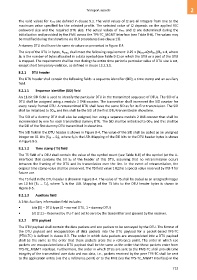Page 723 - 5G Basics - Core Network Aspects
P. 723
Transport aspects 2
The valid values for KFEC are defined in clause 9.3. The valid values of Q are all integers from one to the
maximum value specified for the selected profile. The selected value of Q depends on the applied FEC
codeword size and the required DTU size. The actual values of KFEC and Q are determined during the
initialization and provided by the FME across the TPS-TC_MGMT interface (see Table 8-8). The values may
be modified during the showtime via OLR procedures (see clause 13).
A dummy DTU shall have the same structure as presented in Figure 8.4.
The size of the DTU in bytes, NDTU, shall meet the following requirement: 0.25 ≤ (NDTU+Q×RFEC)/BD ≤ 4, where
BD is the number of bytes allocated in a data symbol (see Table 9-2) on which the DTU or a part of the DTU
is mapped. The requirement shall be met during the entire time period a particular value of DTU size is set,
except short temporary violation, as defined in clause 13.3.1.1.
8.2.1 DTU header
The DTU header shall contain the following fields: a sequence identifier (SID), a time stamp and an auxiliary
field.
8.2.1.1 Sequence identifier (SID) field
An 11-bit SID field is used to identify the particular DTU in the transmitted sequence of DTUs. The SID of a
DTU shall be assigned using a modulo 2 048 counter. The transmitter shall increment the SID counter for
every newly framed DTU. A retransmitted DTU shall have the same SID as for its first transmission. The SID
shall be initialized to 0016 and this shall be the SID of the first DTU transmitted in showtime.
The SID of a dummy DTU shall also be assigned, but using a separate modulo 2 048 counter that shall be
incremented by one for each transmitted dummy DTU. The SID shall be initialized to 0016 and this shall be
the SID of the first dummy DTU transmitted in showtime.
The SID field in the DTU header is shown in Figure 8-4. The value of the SID shall be coded as an unsigned
integer on 11 bits [S10 … S0], where S0 is the LSB. Mapping of the SID bits to the DTU header bytes is shown
in Figure 8-5.
8.2.1.2 Time stamp (TS) field
The TS field of a DTU shall contain the value of the symbol count (see Table 8-8) of the symbol (at the U-
interface) that contains the bit S0 of the header of this DTU, assuming that no retransmission occurs
between the framing of the DTU and its transmission over the line. In the event of retransmission, the
original time stamp value shall be preserved. The TS field value 1 023 is a special value reserved by ITU-T for
future use.
The TS field in the DTU header is shown in Figure 8-4. The value of TS shall be coded as an unsigned integer
on 10 bit [T9 … T0], where T0 is the LSB. Mapping of the TS bits to the DTU header bytes is shown in
Figure 8-5.
8.2.1.3 Auxiliary field
A 3-bit Auxiliary information field includes:
• bits [0] – DTU type (0 = normal DTU, 1 = dummy DTU)
• bit [2:1] – Reserved by ITU-T and set to zero by the transmitter and ignored by the receiver.
8.2.2 DTU payload
The DTU payload shall contain the data packets and eoc packets to be conveyed by the DTU. The format of
the DTU payload and encapsulation of data packets into the DTU payload for a packet-based TPS-TC
(PTM-TC) is defined in clause 8.3. The order in which data packets are encapsulated into a DTU payload
shall be the same as the order that these packets cross the γ reference point. The order in which eoc
packets are encapsulated into a DTU payload shall be the same as the order that these packets enter from
TPS-TC_MGMT interface. Furthermore, the order in which DTUs are sent to the PMS-TC shall provide time
integrity of the transmitted user data and eoc data, i.e., packets received by the peer TPS-TC shall be sent
to the application entity (via the γ reference point) or to the FME (via the TPS-TC_MGMT interface) in the
713

